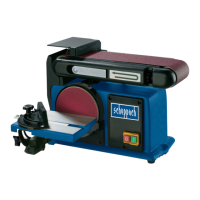www.scheppach.com
GB
|
23
•
• Never leave the working area of the sanding ma-
chine while the tool is running, or as long as it has
not come to an absolute standstill.
6. Remaining hazards
The machine has been built using modern technology
and in accordance with recognized safety rules.
Some hazards, however, may still remain.
• -
gers and hands by improper feeding or placement
of tools.
• Danger of injury from thrown tools due to improper
holding or feeding.
• The use of incorrect or damaged mains cables can
lead to electrical injuries.
• Although having regarded all considerable rules
there may still remain not obvious remaining hazrds.
• Minimize remaining hazards by following the in-
structions in ”Safety Rules”, ”Use only as author-
ized” and in the entire operating manual.
7. Technical data
Dimensions L x W x H 460 x 360 x 280 mm
ø Disc 150 mm
RPM Disc 2980 min
-1
Belt dimensions 915 x 100 mm
Belt speed 7,5 m/s
Belt tilt 0° – 90°
Table size 225 x 160 mm
Table tilt 0°-45°
Weight 16.5 kg
Motor 230-240 V~ / 50 Hz
Power 370 W
Subject to technical changes!
Total vibration values determined in accordance with
EN 62841-1
Sound pressure level L
pA
81 dB(A)
ncertainty K
pA
3 dB
Sound power level L
WA
94 dB(A)
ncertainty K
WA
3 dB
• Attention: This machine has only been designed for
sanding wood or similar materials. The sanding of
the product.
• Always wear safety goggles.
• This machine may only be operated indoors.
• Important: Mount and use the machine on a hori-
zontal surface. A non-horizontal surface can dam-
age the motor.
• If the machine tends to tilt or walk (especially when
sanding long and heavy panels), it must be fastened
• Make sure the sanding belt runs in the correct direc-
tion – see arrows at the back of the belt.
• Make sure the sanding belt is running correctly so
• Make sure the sanding belt is not twisted or loose.
• Firmly hold the workpiece when sanding.
• Always use the fence when using the sanding ma-
chine in horizontal position.
•
using the sanding disc.
• Always hold the workpiece to the side of the sand-
ing disc running downwards, in order to maintain
the workpiece pressed to the table. By using the
upward-running side of the sanding disc, the work-
piece could be ejected and cause injury to persons.
• Always keep a minimum distance of about 1.5 mm
or less between the table or fence and the sanding
belt or disc.
• Do not wear gloves. Do not hold the workpiece with
a cloth during sanding.
• Use sanding belt or disc of the correct grit corre-
sponding with the wood.
• Never sand workpieces too small to be held safely.
• Avoid awkward hand positions where a sudden slip
could cause your hand to touch the sanding belt
or disc.
• When sanding a large piece of material, provide an
additional support at table height.
• Never sand an unsupported workpiece. Secure the
workpiece with the table or the fence. Exceptions
are the sanding of curved workpieces on the outside
of the sanding disc.
• Always clear the table, fence or sanding belt of
scraps or other objects, before turning the ma-
chine on.
• Do not perform any layout assembly or set-up work
on the table while the sanding machine is in op-
eration.

